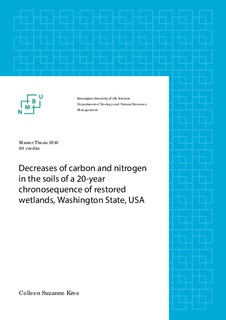| dc.description.abstract | Freshwater wetland restoration is intended to replace both area and function as part of compensatory mitigation, including restoration of biogeochemical soil processes. This study examined the amount of carbon (C) and nitrogen (N) found in the soils of twenty-two wetland restoration sites in the Puget Sound region of Washington State, USA, and assessed whether vegetative strata, hydrologic regime, hydrogeomorphic class, and soil type influenced C and N accumulation rates. The wetland restoration sites were constructed between 1993 and 2013, representing a 20-year chronosequence with multiple sites constructed each year. Soil samples and data regarding vegetative strata, hydrologic regimes, and soil characteristics were collected in July and August 2015, and additional soil samples and hydrologic data was collected in December 2015. Overall, total C decreased over time, with an estimated rate of -0.70 Mg C ha-1 yr-1, while total N increased slightly over time (0.004 Mg N ha-1 yr-1). Soil characteristics such as color and texture were used to divide soils into upper and lower soil layers. The soil layer distinction was a significant variable in assessing trends of C, N, and bulk density (g cm-3). Bulk density (gr cm-3) was found to generally increase with increasing time. There were no statistically significant relationships between the amount of C or N in the soils and hydrogeomorphic class, hydrologic regime, or soil type. Nevertheless, C:N ratio had a negative relationship with increased age, suggesting that C loses were greater than N losses through time. This study reports the surprising result that rather than increasing through time (as is common in natural ecosystems), mitigation processes can lead to an initial decrease through time in average soil C and N. The results suggest that C and N are not specifically influenced by distinct restoration site design components (i.e., vegetation, hydrology, soil type), but that soil amendments added to wetland restoration sites may influence soil biogeochemical processes in unexpected ways. | nb_NO |

